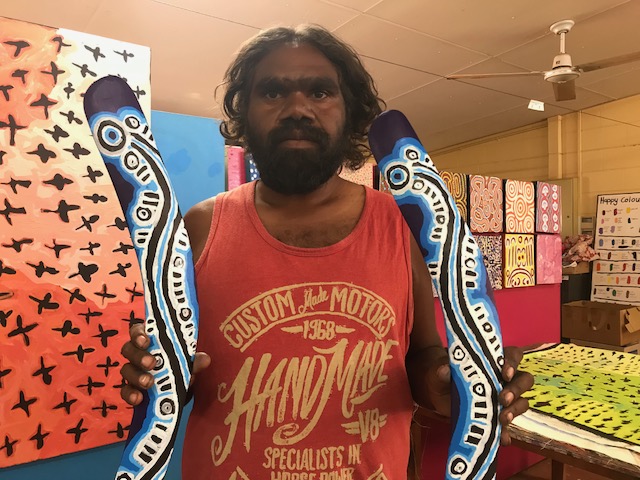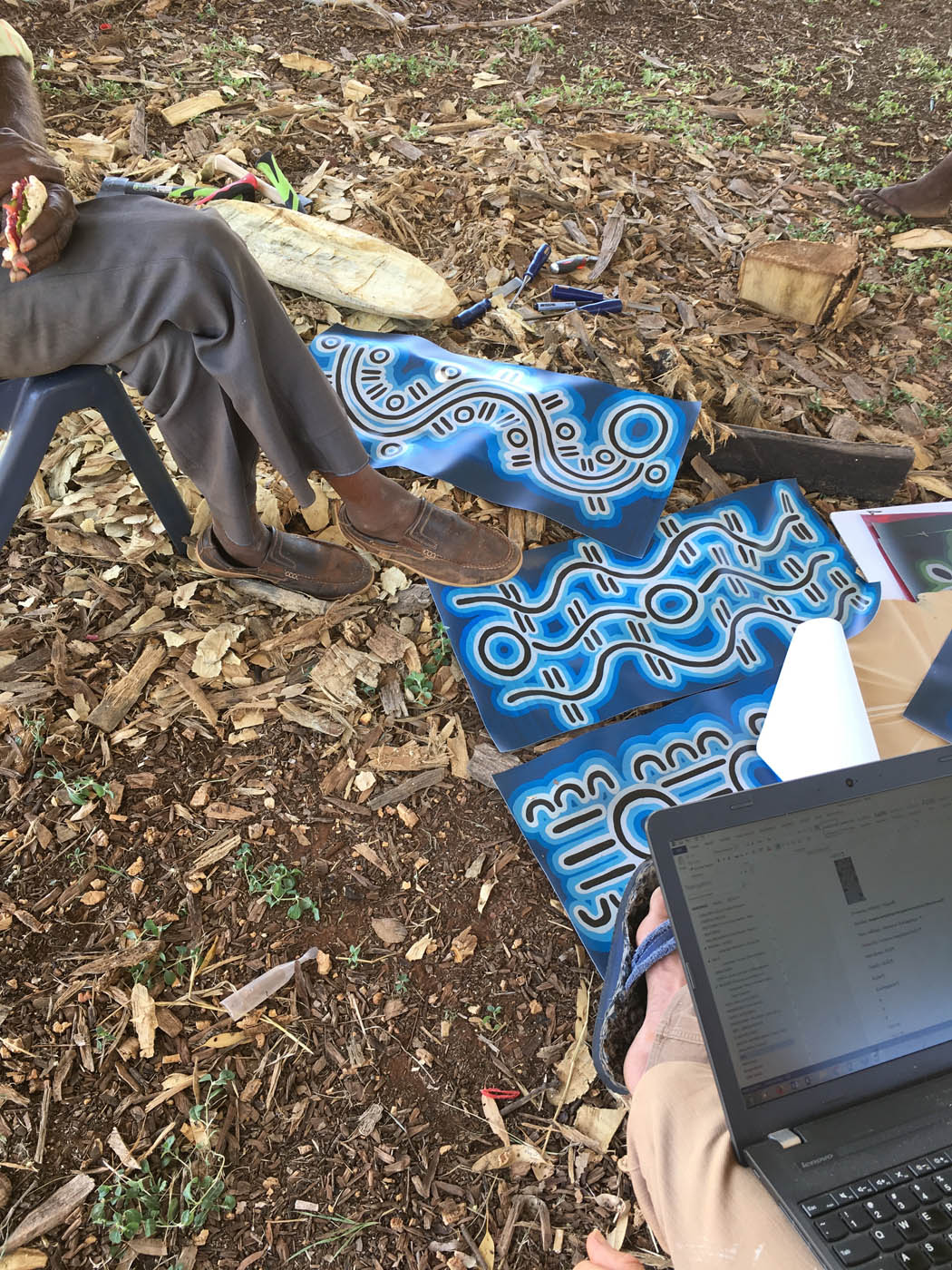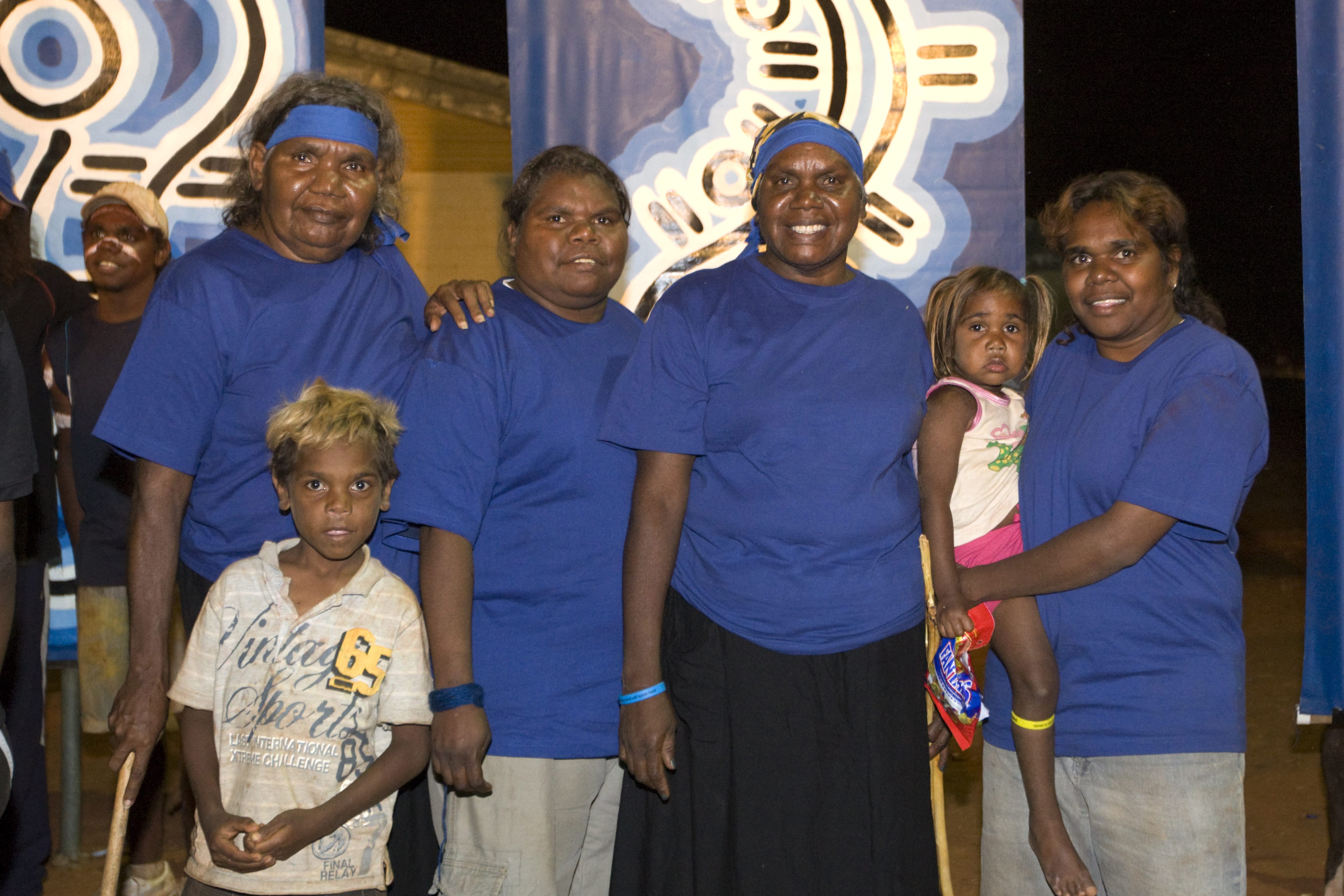Milpirri Banner - NGAPA PIRLINYARNU (Rain at Pirlinyarnu)
Dreaming
Ngapa Pirlinyarnu. This banner depicts rain dreaming at a place called Pirlinyarnu (Mt Farewell). Elders Jerry Jangala Patrick and Lesley Robertson Jampijinpa explain that the large circle is the place called Pirlinyarnu, the two central curved lines are ‘ngawarra’ (flood waters). Small circles are used to depict ‘mulju’ (soakages) and river beds water. The short parallel lines are ‘mangkurdu’ (cumulus & stratocumulus clouds). Wanta Jampijinpa Patrick states that Pirlinyarnu is the only place that Kurlpurlurnu is acknowledged. They gave them the cloud and rainbow only. They only share between each other, and not with the other ngapa (rain) places.
See the Kurlpurlurnu MIlpirri banner - Photos / Information
Belonging to Skin Groups
Jangala, Jampijinpa, Nangala and Nampijinpa (Blue Group)
Drawn By
Possibly drawn by Lesley Jampijinpa Robertson in 2005
Family
In Lajamanu speak with the family of Lesley Jampijinpa Robertson.
See the location of Pirlingyarnu on the South Tanami IPA. Either click on the "Jukuurpa Yirdiyi Kari-Yardiyi Kari" tab, or change to English and click on the "Jukurrpa map" tab. Go along the ranges west of Yuendumu and slightly north. - Map
Dreaming information from Warlukurlangu Arts in Yuendumu
The site depicted in this painting is Pirlinyarnu (Mt. Farewell), about 165 km west of Yuendumu in the Northern Territory. The ‘kirda’ (owners) for the water Dreaming site at Pirlinyarnu are Nangala/Nampijinpa women and Jangala/Jampijinpa men.
Two Jangala men, rainmakers, sang the rain, unleashing a giant storm that collided with another storm from Wapurtali at Mirawarri. A ‘kirrkarlanji’ (Brown Falcon [Falco Berigora]) carried the storm further west from Mirawarri.
The two storms travelled across the country from Karlipirnpa, a ceremonial site for the Water Dreaming near Kintore that is owned by members of the Napaljarri/Japaljarri and Napanangka/Japanangka subsections. Along the way the storms passed through Juntiparnta, a site that is owned by Jampijinpa men. The storm eventually became too heavy for the falcon. It dropped the water at Pirlinyarnu, where it formed an enormous ‘maluri’ (claypan). A ‘mulju’ (soakage) exists in this place today. Whenever it rains today, hundreds of ‘ngapangarlpa’ (bush ducks) still flock to Pirlinyarnu.
Source: Warlukurlangu Art Centre website
See google maps image of Pirlinyarnu (Mt Farewell) - Map
Other
See this old photo of expedition members at Surprise Rock Hole, Mount Farewell region, Northern Territory, 1933 /Michael Terry - Photo
Read language stories
This story is about the ‘kirrkarlanji’ (brown falcon) which carried the water to Pirlinyarnu.
Kirrkarlanji karnalu ngarrirni wutungarnupiyayijala. Kirrkarlanjiji. Maruyijala. Pinkirrpaparnta. Witalku karla nyina wutungarnukuju. Wita - nyanunguju kirrkarlanji.
What we call kirrkarlanji is like the wutungarnu. The Brown Falcon is also dark coloured, it has feathers. It is smaller than the wutungarnu. The Brown Falcon is smaller.
Kuyuyijala karnalu ngarni nyanunguju kirrkarlanjiji. Waljirni karnalurla pinkirrpa, warlungku karnalu purra. Ngarni karnalu.
We also eat that Brown Falcon's flesh. We pull out its feathers and we cook it. Then we eat it.
Jukurrpa kirrkarlanji ngulaju Jangala Jampijinpaku.
The Brown Falcon Dreaming belongs to Jangala and Jampijinpa.
Both eyes the Brown Falcon have little blackish marks. Its feet are just the same as those of the Black Kite.
Ngapa-yiriyiri mean: rainy time, rains, wet weather, continual rain, lasting rain.
Ngapa-yiriyiriji ngulaka ngapa wanti mungakari-mungakari, kapi parrakari-parrakari. Ngapa kujaka wanti mungakari-mungakari kapi parrakari-parrakari, ngulaji ka yajarni wajirrki, marna, watiya kapi jintilyka, jurlakaku miyi ngarninjaku.
Ngapa-yiriyiri is the rainy season when rain falls night after night, day after day. When rain falls night after night, day after day, it makes the green vegetation grow - grass, trees, and makes the grasshoppers come out, (which are) food for birds.
Source: Dictionary Source: Laughren, M., K. L. Hale, and Warlpiri Lexicology Group, 2005 Warlpiri-English Encyclopaedic Dictionary. (Accessed Via Kirrkirr Interface to Electronic Files.) University of Queensland




![A ‘kirrkarlanji’ (brown falcon) is featured in many of the stories from Ngapa Pirlinyarnu banner. Attribution: By Marc Dalmulder from Hamlyn Terrace, Australia (Whistling Kite Uploaded by snowmanradio) [CC BY 2.0 (https://creativecommons.org/licenses/by/2.0)], via Wikimedia Commons.](/sites/default/files/banners/photos/Falco_berigora_-Alice_Springs%2C_Northern_Territory%2C_Australia-8-min.jpg)
